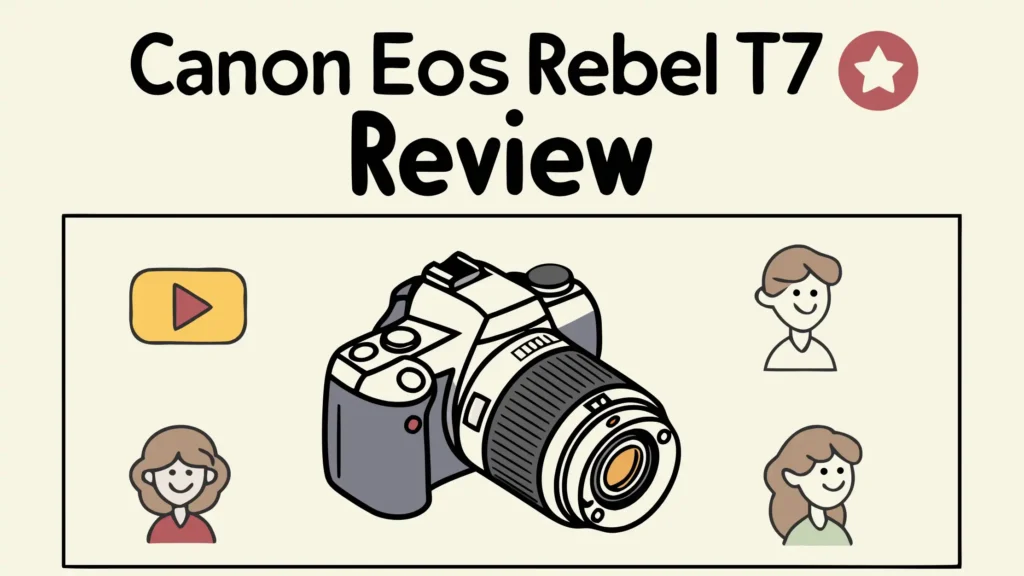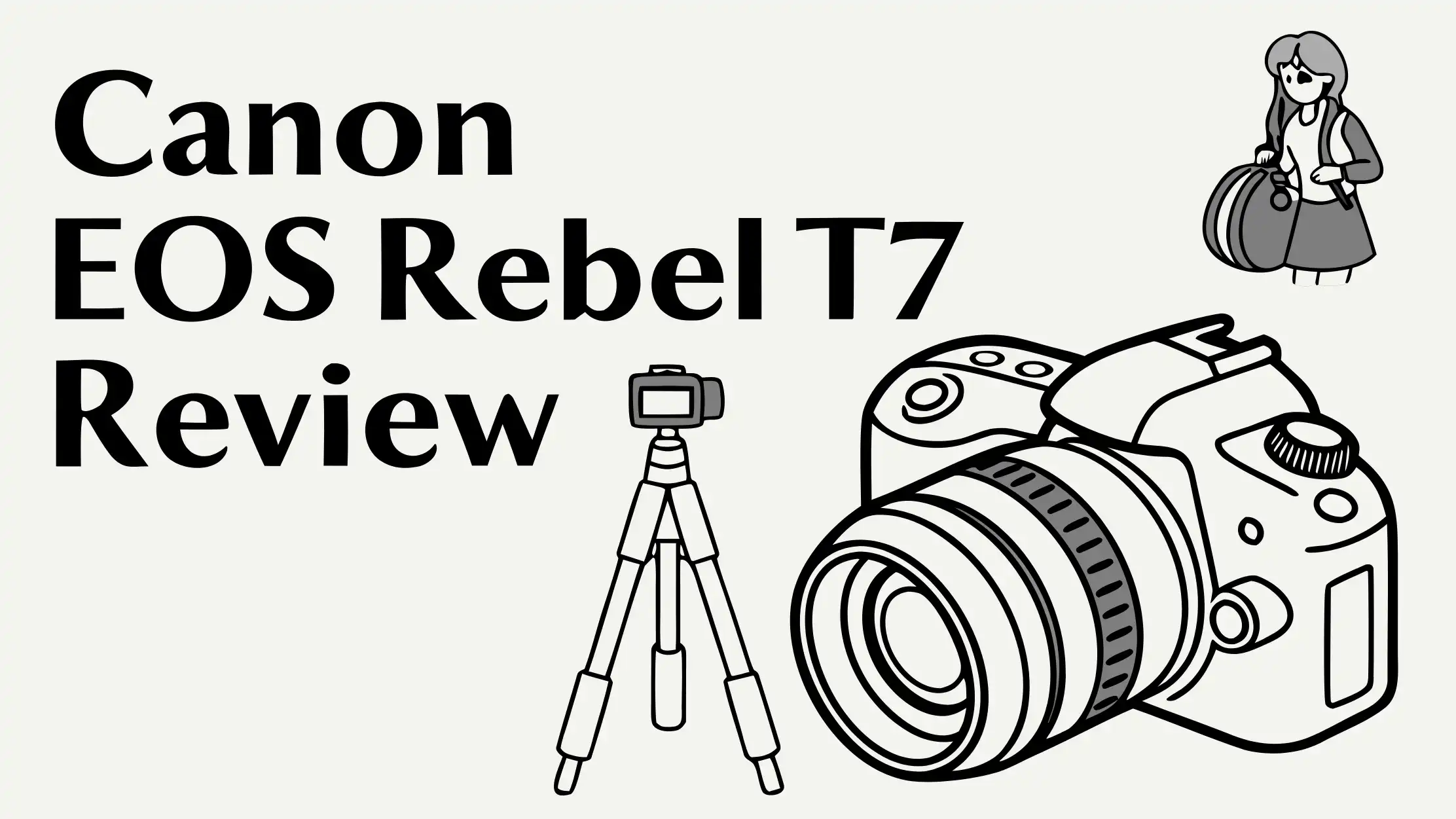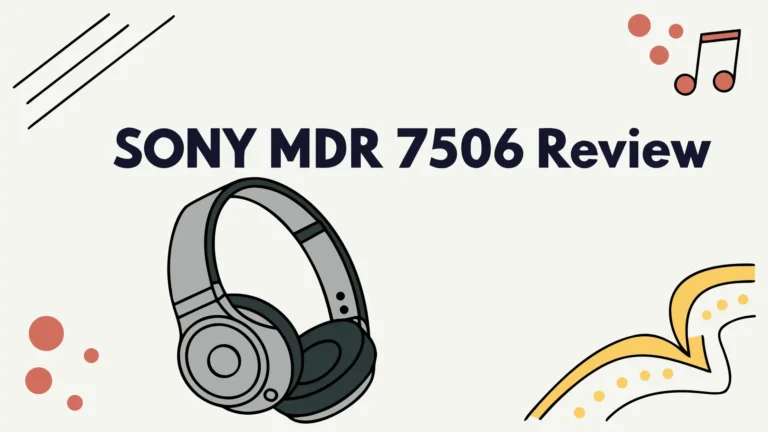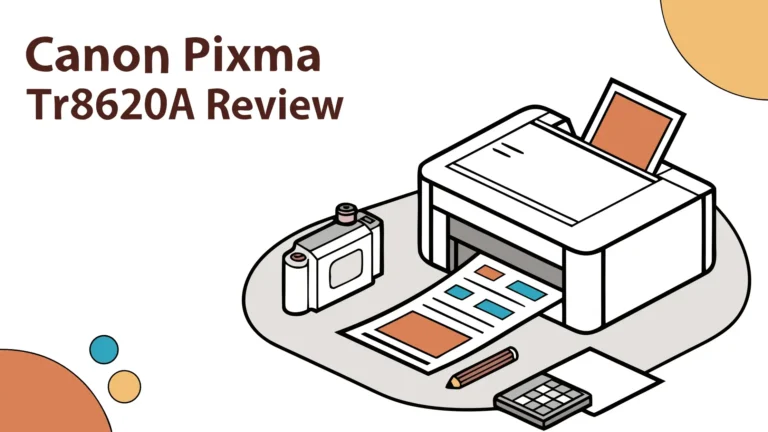Canon EOS Rebel T7 Review: Is This Budget DSLR Still Worth Buying?
Photography beginners face many choices when buying their first camera. The Canon EOS Rebel T7 stands out as one of the most popular entry-level DSLR cameras.
This camera promises excellent image quality at an affordable price point. Many photographers wonder if this older DSLR model remains relevant in today’s market filled with advanced mirrorless options.
This comprehensive review explores every aspect of the Canon Rebel T7. You will discover its strengths, weaknesses, and whether it fits your photography needs.

Key Takeaways
- Excellent Value for Money – The Canon Rebel T7 offers 24.1-megapixel image quality at a budget-friendly price point, making it accessible for beginners who want DSLR performance without breaking the bank.
- User-Friendly Design – Features guided shooting modes and intuitive controls that help photography newcomers learn camera basics while producing quality images from day one.
- Solid Build Quality – Despite being an entry-level camera, the T7 provides reliable construction and comfortable ergonomics that feel professional in hand.
- Limited Modern Features – Lacks 4K video recording and has slower autofocus compared to newer cameras, which may frustrate users wanting cutting-edge technology.
- Great Learning Platform – Serves as an excellent stepping stone for beginners who plan to upgrade later, teaching fundamental photography skills that transfer to advanced cameras.
- Strong Lens Ecosystem – Access to Canon’s extensive EF and EF-S lens collection provides unlimited creative possibilities as your photography skills develop over time.
Canon EOS Rebel T7 Overview
The Canon EOS Rebel T7 entered the market in 2018 as Canon’s most affordable DSLR option. This camera targets photography beginners who want professional image quality without premium pricing. Canon designed the T7 to bridge the gap between smartphone cameras and advanced DSLRs.
- 24.1 Megapixel CMOS (APS-C) sensor with is 100–6400 (H: 12800)
- Built-in Wi-Fi and NFC technology
The camera features a 24.1-megapixel APS-C CMOS sensor that delivers sharp, detailed images. Its DIGIC 4+ image processor handles image processing efficiently while maintaining good color reproduction. The combination produces photos that rival much more expensive cameras in good lighting conditions.
Canon positioned this camera as a learning tool for aspiring photographers. The Scene Intelligent Auto mode analyzes shooting conditions automatically. Creative Auto mode provides simple explanations for camera settings. These features help beginners understand photography concepts while taking better pictures.
The T7 represents Canon’s commitment to making DSLR photography accessible. Its affordable price point removes barriers that prevent people from exploring serious photography. Many professional photographers started their journey with similar entry-level cameras.
However, the camera shows its budget positioning through certain limitations. The 9-point autofocus system feels basic compared to modern standards. 3 frames per second continuous shooting may disappoint action photographers. These compromises help Canon maintain the attractive price point.
Design and Build Quality
The Canon Rebel T7 follows traditional DSLR design principles with modern touches. Its black plastic construction feels solid despite the lightweight build. The camera weighs approximately 475 grams without lens, making it comfortable for extended shooting sessions.
The textured grip provides secure handling even with larger lenses attached. Canon shaped the grip to accommodate different hand sizes comfortably. The thumb rest on the camera back adds stability during one-handed operation. These ergonomic considerations show Canon’s experience in camera design.
Button placement follows Canon’s established layout philosophy. The mode dial sits prominently on the camera top for easy access. Control buttons are logically positioned for intuitive operation. The four-way directional pad provides quick access to common settings without menu diving.
The 3-inch LCD screen dominates the camera back with 920,000 dots resolution. While not touch-sensitive, the display shows bright, accurate colors for image review. The screen performs well in various lighting conditions, though direct sunlight can cause visibility issues.
Build quality exceeds expectations for this price range. All buttons provide tactile feedback without feeling cheap. The battery door and memory card slot close securely with positive clicks. The lens mount shows precision machining that ensures proper lens alignment.
Weather sealing remains absent from this entry-level model. Users should protect the camera from rain and dusty conditions. This limitation requires extra care during outdoor photography adventures but keeps manufacturing costs down.
Key Features and Specifications
The Canon Rebel T7 packs impressive specifications into its budget-friendly package. The 24.1-megapixel APS-C CMOS sensor captures detailed images with excellent dynamic range. This sensor size provides better low-light performance than smaller formats while maintaining compact camera dimensions.
ISO performance ranges from 100 to 6400, expandable to 12800. Lower ISO settings produce clean images with minimal noise. Higher ISO values show acceptable grain levels for an entry-level sensor. The camera handles ISO 3200 reasonably well for most shooting situations.
The DIGIC 4+ image processor manages color reproduction and noise reduction effectively. While not Canon’s latest processor, it delivers consistent results across various shooting conditions. JPEG processing produces vibrant, ready-to-share images straight from the camera.
Autofocus system utilizes 9 focus points with the center point being cross-type. This basic system works adequately for stationary subjects and slow-moving action. AI Servo AF provides continuous focus tracking, though performance lags behind more advanced cameras.
Continuous shooting reaches 3 frames per second, suitable for casual action photography. The camera can capture approximately 7 RAW files or unlimited JPEGs before buffer limitations occur. These specifications meet basic sports and wildlife photography needs.
Built-in flash provides fill lighting for close subjects. The flash covers the 18-55mm kit lens range adequately. Hot shoe compatibility allows external flash units for more advanced lighting setups as skills develop.
Top 3 Alternatives for Canon Rebel T7
- Compact, Lightweight and High-Quality RF Lens with a Versatile Zoom Range of 24-105 millimeter
- Optical Image Stabilization at up to 5 stops of shake correction
- 40X Optical Zoom - 24mm Wide Angle Lens
- 20 Megapixel CMOS Sensor
- CAPTURE SHARP, VIBRANT 20MP PHOTOS: Capture crisp, high-resolution 20MP photos with vivid detail and...
- POWERFUL 40X OPTICAL ZOOM LENS: Zoom in close from far away with an advanced 40x optical zoom lens...
Image Quality Performance
The Canon Rebel T7 delivers impressive image quality that exceeds expectations for its price range. The 24.1-megapixel sensor captures fine details with excellent sharpness when paired with quality lenses. Color reproduction shows Canon’s signature warm tone that many photographers prefer over cooler alternatives.
Dynamic range performance handles moderate contrast scenes well. The camera captures detail in both shadows and highlights when exposed correctly. Highlight recovery shows good results in post-processing, though shadow lifting reveals some noise at higher ISO values.
JPEG processing produces vibrant, contrasty images that look appealing straight from camera. Canon’s Picture Styles allow customization of color, contrast, and sharpness settings. The Standard picture style works well for most situations, while Landscape enhances greens and blues effectively.
RAW file quality provides excellent flexibility for post-processing enthusiasts. The files contain good color information and respond well to exposure and white balance adjustments. 14-bit RAW capture ensures smooth tonal gradations in processed images.
Low-light performance remains acceptable up to ISO 1600 for most uses. ISO 3200 shows noticeable grain but remains usable with proper exposure. Higher ISO values should be avoided except for emergency situations where image quality takes secondary importance to capturing the moment.
Kit lens combination with the EF-S 18-55mm IS II produces sharp results throughout the zoom range. Center sharpness excels at all focal lengths, while corner performance shows slight softness at wider apertures. This pairing provides excellent value for beginning photographers.
Autofocus System Analysis
The Canon Rebel T7 employs a 9-point autofocus system that represents basic DSLR technology. The center focus point features cross-type sensitivity for improved accuracy with both horizontal and vertical details. Eight surrounding points use line-type sensors that work adequately in good lighting conditions.
Focus accuracy performs well with stationary subjects and cooperative lighting. The system locks onto subjects quickly when contrast levels remain high. Low-light focusing struggles below EV 0, requiring assistance from the built-in AF illuminator or manual focus techniques.
AI Servo AF provides continuous focus tracking for moving subjects. Performance works acceptably for slow-moving subjects like walking people or casual sports. Predictive focus capabilities remain limited compared to advanced camera systems, making fast action photography challenging.
Single-shot AF (One Shot) delivers reliable results for portraits, landscapes, and still-life photography. Focus confirmation appears clearly in the viewfinder with audio beep confirmation available. The system rarely misfocuses when subjects provide adequate contrast.
Live View autofocus operates significantly slower than viewfinder focusing. The contrast-detection system searches for focus deliberately, making it unsuitable for quick shooting situations. Face detection works moderately well for portrait photography in Live View mode.
Manual focus assistance includes focus confirmation indicators in the viewfinder. The focusing screen shows adequate brightness for manual focusing with fast lenses. Depth of field preview helps visualize final image sharpness before taking the shot.
Video Recording Capabilities
The Canon Rebel T7 offers Full HD video recording at 1080p resolution with frame rate options of 30fps and 24fps. 720p recording provides 60fps option for smoother motion playback. While lacking 4K capability, the video quality remains acceptable for casual videography and online sharing.
Video autofocus performs adequately but shows obvious hunting in challenging lighting conditions. The contrast-detection system used during video recording operates slower than dedicated video cameras. Manual focus often provides more professional-looking results with practice.
Audio recording utilizes the built-in monaural microphone with basic quality. External microphone support remains unavailable, limiting audio improvement options. Audio levels cannot be adjusted manually, requiring careful attention to recording environments.
Image stabilization from compatible lenses helps reduce camera shake during handheld video recording. The 18-55mm kit lens provides effective stabilization for most video situations. Tripod use remains essential for professional-looking static shots and smooth panning movements.
Exposure control during video recording offers limited options. Manual exposure allows creative control over depth of field and motion blur effects. Auto exposure adapts to changing lighting conditions but may cause distracting brightness fluctuations.
Video quality shows good detail and color reproduction in optimal lighting. Rolling shutter effects appear with fast camera movements or quick-moving subjects. The camera works well for simple video projects but shows limitations for serious videography work.
Battery Life and Storage
The Canon Rebel T7 utilizes the LP-E10 rechargeable lithium-ion battery that provides adequate power for casual shooting sessions. CIPA testing rates the battery for approximately 500 shots per charge when using the viewfinder. Live View usage significantly reduces battery life to around 180 shots due to LCD screen power consumption.
Battery performance varies considerably based on shooting habits and environmental conditions. Cold weather reduces battery capacity noticeably, requiring spare batteries for winter photography. Flash usage and image review time also impact overall battery endurance significantly.
Charging system requires the dedicated LC-E10 battery charger included with the camera. Charging time takes approximately 2 hours for a completely depleted battery. In-camera charging remains unavailable, requiring the external charger for power restoration.
Memory card compatibility includes SD, SDHC, and SDXC cards with UHS-I support for faster data transfer speeds. Write speeds benefit from faster memory cards, especially when shooting RAW files or burst sequences. 32GB cards provide storage for approximately 1,000 JPEG images or 400 RAW files.
Storage management includes in-camera organization features like folder creation and file numbering options. Image protection prevents accidental deletion of important photos. Format options help maintain optimal card performance and organization.
Backup considerations become important for photographers shooting important events. Dual card slots remain absent from this entry-level model, requiring careful memory card management and regular image transfers to computers or cloud storage services.
User Interface and Controls
The Canon Rebel T7 features an intuitive control layout that follows established DSLR conventions. The mode dial provides quick access to various shooting modes including Auto, Scene modes, Creative modes, and Manual controls. Clear labeling helps beginners understand each mode’s purpose and application.
Menu system organizes functions logically across multiple tabs with color-coded categories. Playback menus handle image review and basic editing functions. Shooting menus control camera behavior and image quality settings. Setup menus manage camera preferences and connectivity options.
Quick Control Screen accessible via the SET button provides faster access to common settings. This graphical interface shows current settings clearly with easy navigation using the directional pad. Beginners find this system more approachable than traditional menu diving.
Button customization remains limited but adequate for this camera level. Function button can be programmed for frequently used settings. AE Lock button serves double duty for exposure and focus locking functions. ISO button provides direct access to sensitivity settings.
Information display shows comprehensive shooting data in the viewfinder and on the LCD screen. Electronic level helps achieve straight horizons in landscape photography. Histogram display assists with exposure evaluation during image review and Live View shooting.
Help system includes Feature Guide that explains camera functions in plain language. Scene descriptions help users select appropriate modes for different shooting situations. This educational approach accelerates the learning process for photography newcomers.
Lens Compatibility and Options
The Canon Rebel T7 accepts all Canon EF and EF-S mount lenses, providing access to one of photography’s most extensive lens ecosystems. EF-S lenses designed specifically for APS-C sensors offer compact, affordable options perfect for this camera. EF lenses provide professional-grade optics with full-frame compatibility for future upgrades.
Kit lens options typically include the EF-S 18-55mm f/3.5-5.6 IS II as the standard choice. This lens covers equivalent focal length of approximately 29-88mm in full-frame terms. Image stabilization helps achieve sharp handheld shots in various lighting conditions.
Prime lens selection offers excellent image quality and creative possibilities. The EF 50mm f/1.8 STM provides exceptional value for portrait photography with beautiful background blur. EF-S 24mm f/2.8 STM delivers wide-angle perspectives for landscape and architectural photography.
Telephoto options include the EF-S 55-250mm f/4-5.6 IS STM for wildlife and sports photography. This lens extends the reach significantly while maintaining affordable pricing and effective image stabilization. Professional telephoto lenses remain compatible but may overwhelm this camera’s modest size.
Third-party lens support includes options from Sigma, Tamron, and Tokina manufacturers. These lenses often provide excellent value with features matching or exceeding Canon’s offerings. Compatibility remains excellent with modern third-party options featuring electronic communication.
Macro photography becomes accessible through dedicated macro lenses or close-focusing zoom lenses. The EF-S 60mm f/2.8 Macro USM delivers exceptional close-up capabilities. Extension tubes provide budget-friendly macro capabilities with existing lenses.
Performance in Different Shooting Conditions
Daylight Photography
The Canon Rebel T7 excels in bright daylight conditions where its 24.1-megapixel sensor captures exceptional detail and color accuracy. Dynamic range handles moderate contrast scenes effectively, preserving detail in both shadows and highlights. Base ISO performance produces clean, sharp images with vibrant colors that require minimal post-processing.
Outdoor portraits benefit from the camera’s excellent color reproduction and skin tone rendering. Landscape photography showcases the sensor’s ability to capture fine details in foliage, clouds, and architectural elements. Street photography becomes enjoyable with the camera’s responsive handling and reliable autofocus performance.
Low Light Performance
Indoor photography reveals the T7’s limitations as ISO values climb above 1600. Noise levels become noticeable at ISO 3200 but remain acceptable for casual use. Image stabilization from compatible lenses helps achieve sharp shots at slower shutter speeds, extending the camera’s low-light usability.
Available light photography requires careful exposure technique to maximize image quality. Exposure compensation helps fine-tune brightness levels without pushing ISO unnecessarily high. Prime lenses with wider apertures significantly improve low-light performance and creative possibilities.
Action Photography
Sports photography challenges the T7’s 3 fps continuous shooting and basic autofocus system. Predictive focus tracking works adequately for slow-moving subjects but struggles with erratic movement patterns. Buffer limitations require careful timing for important moments.
Children and pets photography benefits from the camera’s silent shooting modes and face detection capabilities. Burst shooting captures fleeting expressions and spontaneous moments effectively. Fast shutter speeds freeze motion cleanly when adequate light permits.
Connectivity and Sharing Features
The Canon Rebel T7 includes built-in Wi-Fi connectivity that enables wireless image transfer and remote camera control. Canon Camera Connect app provides smartphone connectivity for easy sharing to social media platforms. NFC technology simplifies pairing with compatible Android devices through simple tap-to-connect functionality.
Wireless image transfer operates reliably within reasonable distances from your mobile device. JPEG images transfer quickly while RAW files require more time due to larger file sizes. Batch transfer capabilities help move multiple images efficiently for immediate sharing or backup purposes.
Remote shooting through the smartphone app allows creative perspectives and self-portraits without physical camera access. Live View streaming to your phone enables precise composition and focus confirmation. Timer functions and exposure controls provide comprehensive remote operation capabilities.
Direct printing supports Canon SELPHY printers and other compatible wireless printers. Print layouts include various sizes and formats for physical photo sharing. DPOF compatibility enables print ordering through photo labs and kiosks.
Computer connectivity utilizes USB 2.0 for direct file transfer and tethered shooting with compatible software. EOS Utility provides comprehensive camera control from computers. Image browser functionality helps organize and process captured images efficiently.
Cloud integration works through Canon’s image.canon service for automatic backup and sharing. Storage plans provide various capacity options for different usage levels. Multi-device access enables image viewing and sharing across multiple platforms and devices.
Pros and Cons
Advantages
Exceptional Value – The Canon Rebel T7 delivers professional image quality at an entry-level price point that makes DSLR photography accessible to budget-conscious beginners. Build quality exceeds expectations with solid construction and comfortable ergonomics.
User-Friendly Operation – Guided shooting modes and intuitive controls help beginners learn photography fundamentals while producing quality results. Educational features accelerate the learning process without overwhelming newcomers with complex settings.
Extensive Lens Selection – Access to Canon’s vast EF and EF-S lens ecosystem provides unlimited creative possibilities as skills develop. Affordable lens options keep system costs reasonable while professional lenses remain available for future growth.
Reliable Performance – Consistent autofocus and accurate exposure metering deliver dependable results across various shooting conditions. Long battery life supports extended shooting sessions without frequent recharging interruptions.
Excellent Image Quality – 24.1-megapixel resolution captures fine details with natural color reproduction that requires minimal post-processing. RAW file quality provides excellent flexibility for advanced editing and creative expression.
Disadvantages
Limited Video Features – Lack of 4K recording and basic video autofocus make this camera less appealing for content creators and videographers. No external microphone input limits audio quality improvements for video projects.
Basic Autofocus System – 9-point AF system feels outdated compared to modern cameras with hundreds of focus points. Slow Live View focusing makes the camera less responsive for certain shooting situations.
No Weather Sealing – Lack of environmental protection requires extra care during outdoor photography in challenging weather conditions. Build materials show budget positioning despite overall solid construction quality.
Limited Connectivity – Absence of Bluetooth and slow Wi-Fi transfer speeds hamper modern workflow integration. No USB charging requires carrying the dedicated battery charger for extended trips.
Performance Limitations – 3 fps continuous shooting and small buffer capacity restrict action photography capabilities. High ISO noise becomes problematic above ISO 3200 for quality-conscious photographers.
Comparison with Competitors
Canon Rebel T7 vs Nikon D3500
The Nikon D3500 represents the T7’s primary competitor in the entry-level DSLR market. Both cameras feature 24-megapixel APS-C sensors with similar image quality characteristics. Nikon’s superior ergonomics and longer battery life provide practical advantages for extended shooting sessions.
Autofocus performance favors the Nikon with 11 focus points compared to Canon’s 9-point system. Guide Mode on the D3500 offers more comprehensive shooting assistance for beginners. Price positioning remains similar between both cameras with frequent promotional pricing.
Lens ecosystem gives Canon a slight advantage with more affordable entry-level options and broader selection. Third-party support remains excellent for both systems. Future upgrade paths depend on brand preference and specific photographic interests.
Canon Rebel T7 vs Canon EOS R100
The Canon EOS R100 represents the mirrorless alternative to traditional DSLR design. Faster autofocus and 4K video capability showcase modern technology advantages. Smaller size and electronic viewfinder appeal to photographers preferring compact camera systems.
Battery life strongly favors the T7 with traditional DSLR efficiency. Optical viewfinder provides natural viewing experience preferred by some photographers. Lens selection remains broader for EF/EF-S mount compared to newer RF mount options.
Price positioning places the R100 slightly higher than the T7, reflecting newer technology and features. Learning curve may be easier with traditional DSLR controls for beginners familiar with basic camera operation principles.
Who Should Buy the Canon Rebel T7
Ideal Candidates
Photography beginners seeking their first serious camera will find the T7 an excellent starting point. Students learning photography fundamentals benefit from the camera’s educational features and affordable pricing. Budget-conscious enthusiasts wanting DSLR image quality without premium costs represent perfect target customers.
Casual photographers upgrading from smartphones or point-and-shoot cameras will appreciate the improved image quality and creative control. Family photographers documenting important moments benefit from reliable performance and easy operation. Travel photographers on tight budgets gain access to interchangeable lenses and manual controls.
Hobbyists exploring photography as a creative outlet find the T7 provides room for growth without overwhelming complexity. Gift buyers seeking meaningful presents for photography-interested family members or friends make excellent candidates for this camera system.
Poor Matches
Professional photographers requiring advanced features and performance should consider higher-end models. Video content creators needing 4K recording and advanced video features will find significant limitations. Sports photographers demanding fast autofocus and high continuous shooting rates will experience frustration.
Pixel peepers obsessed with maximum image quality should invest in full-frame sensors and premium lenses. Technology enthusiasts wanting cutting-edge features will find the T7’s specifications outdated. Heavy users shooting thousands of images weekly may prefer more robust camera bodies.
Impatient users expecting instant smartphone-like operation may struggle with traditional DSLR learning curves. Minimalists preferring compact camera systems should consider mirrorless alternatives for reduced size and weight.
Value for Money Assessment
The Canon Rebel T7 delivers exceptional value in the entry-level DSLR market with pricing that makes quality photography accessible to broad audiences. Cost per feature analysis shows competitive positioning against similar cameras from other manufacturers. Long-term value remains strong due to extensive lens ecosystem and upgrade possibilities.
Initial investment includes camera body, kit lens, memory card, and basic accessories for approximately $500-600 depending on retailer promotions. Additional lens purchases remain optional but provide significant creative expansion opportunities. System costs compare favorably to equivalent mirrorless setups when considering lens pricing.
Depreciation rates follow typical patterns for entry-level cameras but hold value reasonably well due to continued popularity. Resale market remains active with steady demand from beginning photographers. Trade-in value helps offset upgrade costs when advancing to higher-end cameras.
Hidden costs include additional batteries, larger memory cards, camera bags, and cleaning supplies. Lens purchases represent the primary long-term investment for system expansion. Total ownership costs remain reasonable compared to premium camera systems.
Alternative investment options at similar price points include older full-frame DSLRs, entry-level mirrorless cameras, or premium point-and-shoot models. Feature comparison generally favors the T7 for image quality and creative control possibilities.
Tips for Getting the Best Results
Optimal Settings
Image quality settings should prioritize RAW+JPEG capture for maximum flexibility in post-processing while maintaining shareable JPEG files. ISO Auto with maximum limit set to 1600 provides good balance between image quality and shooting flexibility. Single-point autofocus improves accuracy for static subjects and portraits.
Picture Style selection depends on intended use, with Standard working well for most situations. Landscape style enhances greens and blues for outdoor photography. Portrait style provides flattering skin tones for people photography. Custom Picture Styles allow fine-tuning for specific preferences.
Metering mode should remain on Evaluative for most shooting situations. Spot metering helps with high-contrast scenes requiring precise exposure control. Center-weighted metering works well for backlit portraits and challenging lighting conditions.
Shooting Techniques
Proper holding technique involves gripping the camera firmly with both hands, with elbows braced against the body for stability. Breathing control during shutter release minimizes camera shake. Follow-through after pressing the shutter prevents premature camera movement.
Focus technique benefits from single-point AF selection for precise control over focus placement. Back-button focus separation improves control over focus and exposure timing. Manual focus provides ultimate precision for macro and landscape photography.
Exposure management requires understanding the exposure triangle relationship between aperture, shutter speed, and ISO. Exposure compensation fine-tunes brightness levels without switching to manual mode. Histogram reading prevents overexposure and optimizes dynamic range usage.
Recommended Accessories
Essential accessories include extra LP-E10 batteries, fast SDHC memory cards, and a sturdy camera strap. Lens cleaning kit maintains optical performance. Camera bag protects equipment during transport and storage.
Tripod selection should balance stability with portability for travel photography. Remote shutter release prevents camera shake during long exposures and self-portraits. External flash expands lighting possibilities for indoor and portrait photography.
Lens recommendations include the EF 50mm f/1.8 STM for portrait photography and the EF-S 10-18mm f/4.5-5.6 IS STM for wide-angle landscapes. Circular polarizing filter reduces reflections and enhances sky contrast. UV filters provide lens protection without image quality degradation.
Long-term Ownership Experience
Durability and Reliability
Long-term testing reveals the Canon Rebel T7 maintains consistent performance throughout its operational lifespan. Shutter durability typically exceeds 100,000 actuations before requiring service. Button reliability shows minimal wear with normal usage patterns over several years of ownership.
Weather resistance limitations require careful handling in challenging conditions, but proper care ensures longevity. Lens mount precision maintains accurate alignment throughout the camera’s life. LCD screen durability benefits from screen protectors for scratch prevention.
Common issues include battery door loosening with heavy use and mode dial stiffness developing over time. Firmware updates address occasional operational bugs and improve compatibility with newer accessories. Service availability remains excellent through Canon’s support network.
Upgrade Path Considerations
System compatibility ensures lens investments transfer to future Canon cameras. EF-S lenses work with all Canon APS-C cameras, while EF lenses provide full-frame upgrade compatibility. Accessory compatibility includes flashes, remote releases, and other system components.
Natural upgrade progression typically leads to Canon EOS 90D or Canon EOS R7 for advanced APS-C performance. Full-frame options include Canon EOS R8 or Canon EOS 6D Mark II depending on feature priorities. Lens collection influences upgrade timing and model selection.
Trade-in value helps offset upgrade costs when transitioning to higher-end cameras. Timing considerations balance new feature needs against current camera capabilities. Skill development often outpaces camera limitations, making upgrades worthwhile investments.
Community and Support
Online communities provide extensive support through forums, social media groups, and educational resources. Canon’s official support includes comprehensive documentation, software updates, and customer service. Third-party resources offer tutorials, tips, and creative inspiration.
Local camera stores provide hands-on support, training classes, and equipment rental services. Photography workshops help maximize camera potential and develop artistic vision. User groups facilitate knowledge sharing and collaborative learning opportunities.
Repair services remain widely available through authorized Canon service centers and independent repair shops. Parts availability ensures long-term serviceability for this popular camera model. Software support continues through regular updates and compatibility improvements.
Frequently Asked Questions
Is the Canon Rebel T7 good for beginners?
Yes, the Canon Rebel T7 is excellent for beginners due to its user-friendly design and guided shooting modes. The camera provides automatic settings that produce quality results while offering manual controls for learning advanced techniques. Educational features help users understand photography concepts without overwhelming complexity.
Can the Canon T7 shoot 4K video?
No, the Canon Rebel T7 cannot record 4K video. The camera is limited to Full HD 1080p recording at 30fps and 24fps, plus HD 720p at 60fps. For 4K video capability, consider newer models like the Canon EOS R50 or Canon EOS M50 Mark II.
What lenses work with the Canon Rebel T7?
The Canon Rebel T7 accepts all Canon EF and EF-S mount lenses. This includes the kit lens EF-S 18-55mm, popular prime lenses like the EF 50mm f/1.8, and professional telephoto lenses. Third-party lenses from Sigma, Tamron, and Tokina also provide excellent compatibility and value.
How long does the Canon T7 battery last?
The LP-E10 battery provides approximately 500 shots when using the optical viewfinder, according to CIPA testing standards. Live View usage reduces this to around 180 shots due to LCD screen power consumption. Cold weather and flash usage significantly impact battery performance, making spare batteries essential.
Is the Canon Rebel T7 worth buying in 2024?
The Canon Rebel T7 remains worth buying for budget-conscious beginners seeking DSLR image quality at an affordable price. However, consider newer mirrorless alternatives like the Canon EOS R100 for modern features including 4K video and faster autofocus. Your choice depends on budget constraints and feature priorities.
Can you use old Canon lenses on the Rebel T7?
Yes, older Canon EF lenses work perfectly with the Rebel T7, providing full compatibility with autofocus and image stabilization functions. Very old manual focus lenses can be adapted but lose electronic communication. The extensive backwards compatibility makes this camera excellent for photographers with existing Canon lens collections.
Hi, I’m Juli! I’m a tech enthusiast with a passion for discovering and testing the latest gadgets and AI innovations. I created GearGaze to share honest, practical insights that help you make smarter tech decisions.
Last update on 2025-10-21 / Affiliate links / Images from Amazon Product Advertising API







